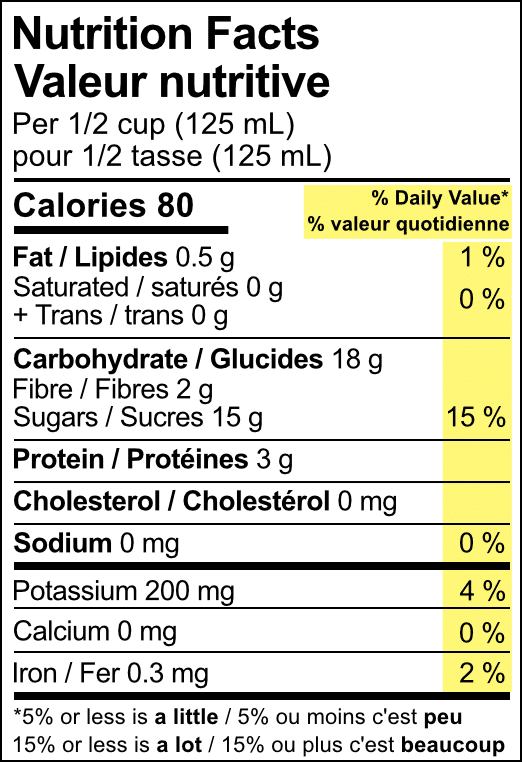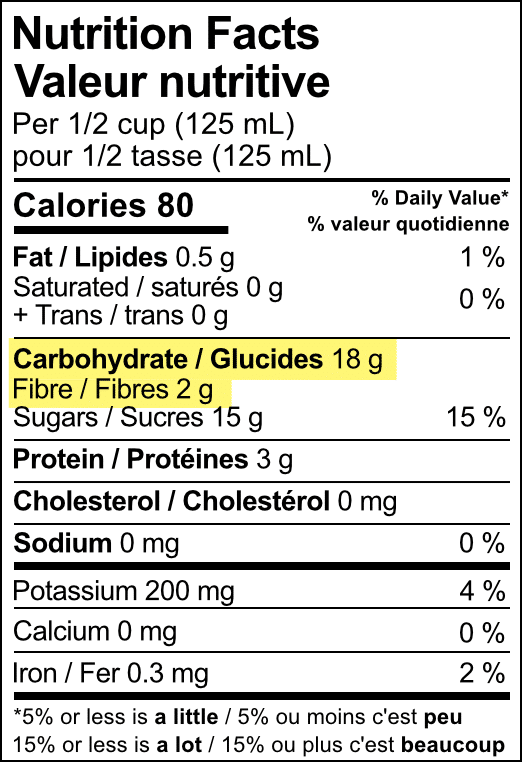
Food Labels
How to Read Food Labels
Reading food labels can help you see what is in the food you buy. Knowing what is in the food you buy can help you manage your blood sugar. A food label will tell you how much fibre, sugar, fat, and sodium you are eating.
It may be hard to make sense of a food label at first, but there are simple ways to use these labels.
There are 3 places to learn about food from a food label:
- list of ingredients
- nutrition facts table
- nutrition claims

List of Ingredients
All ingredients in the food item are listed by most to least amount of weight. This means that foods contain:
- more of the ingredients at the start of the list
- less of the ingredients at the end of the list
The ingredient list can help you look for certain ingredients and help you avoid those that you have been advised not to eat.
Sugar in your diet will raise your blood sugar.
Sugar appears in many forms. Look for the names below in the ingredient list to find sugar in your food.
- molasses
- honey
- cane sugar
- sugar beets
- maple syrup
- malt syrup
- cane syrup
- high maltose corn syrup
- fruit puree
- juice
- agave
- sucrose
- brown sugar
- anhydrous dextrose
- fruit-juice concentrate
- liquid sugar
- invert sugar
- dextrin
- dextrose
- glucose-fructose
- brown rice syrup
- high fructose corn syrup
It can be confusing to remember all the names for sugar, but the good news is that food labels in Canada make it easier to identify all the sources of sugar in a food by grouping them together in the ingredient list.
The example below is an ingredient list for a food that has a lot of sugar. You can see how the sugar-based ingredients are all grouped together at the start of the list. Try to limit foods that have sugars listed as the first ingredient:
| INGREDIENTS: SUGARS (GLUCOSE-FRUCTOSE, SUGAR, HIGH-MALTOSE CORN SYRUP), CHICORY ROOT EXTRACT (INULIN FIBRE), WHOLE GRAIN ROLLED OATS, PUFFED WHEAT, WHOLE GRAIN BARLEY FLAKES, PALM KERNAL OIL |
Nutrition Facts Table
Using the Nutrition Facts Table
The nutrition facts table tells you how much fat, protein, carbohydrate, and other nutrients are in the food you eat.
You can use the nutrition facts table to help you manage your diabetes:
- Look for the amount of nutrients in the foods you choose.
- Compare the amount of nutrients in different foods so you can make the healthier choice.
- Know what words to look for on the ingredients list to know if the food has saturated fat, sodium, or sugar.
The nutrition facts table gives you information about the amount of fat, protein, carbohydrate, and other nutrients in food.
To manage your diabetes, look for the amount of:
Use the % Daily Value to Make Healthy Food Choices
The % Daily Value (% DV) is found on the right-hand side of a nutrition facts table. It is a guide to help you make informed food choices. You can use the % DV to check if a food has a little or a lot of a nutrient.
How to read the % DV:
- 5% or less is a little. If a food has 5% or less of a nutrient then it would be considered low in that nutrient.
- 15% or more is a lot. If a food has 15% or more of a nutrient then it would be considered high in that nutrient.
Use the % DV to:
- Compare two foods to help you make an informed food choice
- Choose foods that are
- higher in the nutrients you may want more of (such as fibre)
- lower in the nutrients you want to avoid or eat less of (such as saturated fat, trans fats, and sodium)


The amount of carbohydrate on the nutrition facts table is for total carbohydrate. This total includes starch, fibre, and sugars.
Note: If you are counting carbohydrates to manage your blood sugar, subtract the amount of fibre from the total carbohydrate listed. Do this because fibre does not raise your blood sugar.
Use the label on this page as an example.
- There are 18 grams (g) of total carbohydrate
- There are 2 grams (g) of fibre
- Subtract the amount of fibre (2g) from the total carbohydrate (18g)
- 18g (total carbohydrate) subtract 2g (fibre) equals 16g
- This means there are 16 grams of carbohydrate that will turn into sugar in your body (instead of 18 grams)
Fibre helps to manage your blood sugar, blood cholesterol, and blood pressure. Women should aim to eat 25 grams or more of fibre each day, and men should aim for 38 grams or more of fibre each day to keep your body healthy and manage your blood sugar.
- Look for products that have a % Daily Value (% DV) of fibre of at least 15% or higher
- Compare the % DV of fibre between two products. A product with the higher % DV is the higher fibre choice.
The amount of sugar on the nutrition facts table includes sugars found naturally in foods (like in fruit and milk) plus added sugars such as white sugar, honey, and syrups.
Fruit and milk are nutritious foods. The sugar found naturally in foods like fruit and milk is not harmful to your health, so you do not need to avoid these foods. However, added sugars like white sugar, honey, and syrups, should be limited because they can quickly raise your blood sugars and triglycerides (a type of fat in your blood), and they do not provide you with any health benefits.
Aim to lower the amount of food and drinks you have that include added sugar or are sweetened:
- Look at the ingredient list to see if a food has added sugars.
- Choose foods with less than 5% Daily Value for sugar on the nutrition facts table.
The amount of fat in your food is on the nutrition facts table.
Look for products with little saturated fat and no trans fat. Use the % Daily Value (%DV) to help you. A food with 5% DV or less of saturated fat is a low fat choice.
Look at the ingredient list to see if a food has saturated fat and trans fat. Artificial trans fats have been banned in Canada from being added to foods due to their harmful effect on our health. Some foods can have small amounts of naturally occurring trans fats like dairy products, some meats and oils.
The amount of sodium in a food is listed on the nutrition facts table. Too much sodium can increase your risk for high blood pressure.
A food with 5% Daily Value of sodium or less is a low sodium choice.
Sodium appears in many forms. Look at the ingredient list to see if a food has sodium.
What to Look for on the Ingredient List
These ingredients tell you there is sugar in the food:
- molasses
- honey
- cane sugar
- sugar beets
- maple syrup
- malt syrup
- cane syrup
- high maltose corn syrup
- fruit puree
- juice
- agave
- sucrose
- brown sugar
- anhydrous dextrose
- fruit-juice concentrate
- liquid sugar
- invert sugar
- dextrin
- dextrose
- glucose-fructose
- brown rice syrup
- high fructose corn syrup
Saturated fat
These ingredients tell you there is saturated fat in the food:
- butter
- ghee
- coconut or coconut oil
- lard, shortening, suet, chicken fat, bacon fat, tallow, or beef fat
- cocoa butter
- palm or palm kernel oil
- powdered whole milk solids
Trans fat
These ingredients tell you there is trans fat in the food:
- hydrogenated or partially hydrogenated fats and oils
- margarine and shortening made with hydrogenated or partially hydrogenated fats or oils
Note: In Canada, these types of fats have been banned from being added to foods due to their harmful effects on your health.
These ingredients tell you there is sodium in the food:
- soy sauce
- fish sauce
- salt (sea salt, Himalayan pink salt, kosher salt, rock salt, table salt)
- any ingredients with the word ‘sodium’ listed in it (such as monosodium glutamate, sodium nitrate, sodium citrate)
- baking soda (sodium bicarbonate) or baking powder
Chart adapted from Unlock Food (opens in new window)
Nutrition Claims
Some packaged foods have nutrition claims. There are two types of nutrition claims:
- Nutrient content claims: Nutrient content claims tell you about the amount of a nutrient in a food. These claims can help you choose foods that have a nutrient that you may want less of (such as sugar) or that you may want more of (such as fibre).
- Health claims: Health claims tell you how a food can improve your health when you eat it as part of your healthy diet. Here is an example of a health claim from Health Canada: “a healthy diet containing foods high in potassium and low in sodium may reduce the risk of high blood pressure, a risk factor for stroke and heart disease”.
Nutrition claims follow rules from Health Canada. These rules make sure the claims are used in the same way on all food products. These claims only tell you about a few key nutrients. Read the nutrition facts table to make food choices that are best for you.
“Cholesterol free” or “No cholesterol”
What it means: A very small amount
Where you might see this claim: Potato
Beware: Cholesterol only comes from animals. Cholesterol free products may still be high in fat.
“Low fat”
What it means: A very small amount of fat. 3 grams of fat or less per serving.
Where you might see this claim: Fruit bottom yogurt
Beware: Low fat does not mean low in sugar. Choose low fat yogurt with no sugar added.
“No sugar added”
What it means: Sugar has not been added to the product.
Where you might see this claim: Juice
Beware: Juices are high in calories and have natural sugar.
“Light”
What it means: Foods that have less fat or calories (energy).
Where you might see this claim: Light peanut butter
Beware: Light can also mean the colour or texture such as “light” or “lite” olive oil.